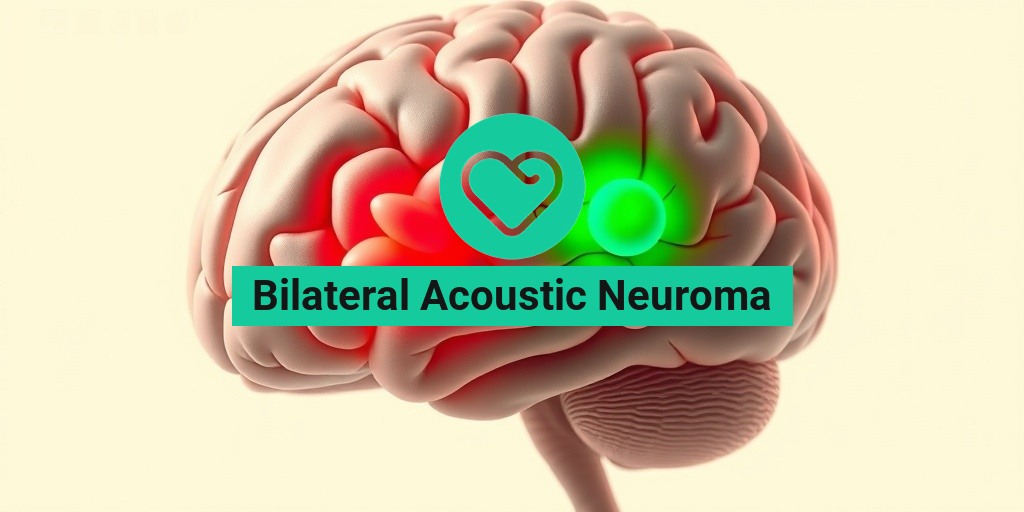What Is Bilateral Acoustic Neuroma?
Bilateral acoustic neuroma, also known as vestibular schwannoma, is a rare, benign tumor that develops on the vestibulocochlear nerve, which is responsible for hearing and balance. When these tumors occur on both sides of the head, they are referred to as bilateral acoustic neuromas. This condition is most commonly associated with a genetic disorder known as neurofibromatosis type 2 (NF2), which significantly increases the risk of developing these tumors.
Understanding the Condition
Acoustic neuromas arise from Schwann cells, which are responsible for the myelin sheath that insulates nerve fibers. While these tumors are typically slow-growing and non-cancerous, their presence can lead to various complications due to their location near critical structures in the brain.
In individuals with NF2, the likelihood of developing bilateral acoustic neuromas is significantly higher, often leading to the diagnosis of the condition in their late teens or early adulthood. However, sporadic cases can occur in individuals without NF2, albeit much less frequently.
Diagnosis and Imaging
Diagnosing bilateral acoustic neuroma typically involves a combination of clinical evaluation and imaging studies. MRI scans are the gold standard for visualizing these tumors, allowing healthcare providers to assess their size and impact on surrounding structures. In some cases, CT scans may also be utilized, but MRI provides a more detailed view of soft tissues.
Symptoms of Bilateral Acoustic Neuroma
The symptoms of bilateral acoustic neuroma can vary significantly from person to person, largely depending on the size of the tumors and their impact on nearby nerves. Here are some common symptoms associated with this condition:
Hearing Loss
One of the most prevalent symptoms of bilateral acoustic neuroma is hearing loss, which may occur gradually or suddenly. This hearing loss typically affects one ear more than the other, but as the condition progresses, it can impact both sides. Patients may experience difficulty understanding speech, especially in noisy environments.
Tinnitus
Tinnitus, or ringing in the ears, is another common symptom. Individuals may hear sounds that are not present in the environment, which can be distressing and may interfere with daily activities.
Balance Issues
Since the vestibulocochlear nerve is also responsible for balance, patients may experience balance problems or dizziness. This can lead to unsteadiness while walking or an increased risk of falls, making it essential for individuals to seek medical advice if they notice these symptoms.
Facial Weakness or Numbness
As the tumors grow, they can exert pressure on adjacent nerves, leading to facial weakness or numbness. This can manifest as difficulty with facial expressions or sensations on one side of the face. In some cases, patients may also experience pain or discomfort in the facial region.
Other Symptoms
Other less common symptoms may include:
- Headaches: Persistent headaches can occur due to increased intracranial pressure.
- Vision Problems: In rare cases, vision disturbances may arise if the tumor affects the optic nerve.
- Difficulty Swallowing: This can occur if the tumor impacts nearby structures.
When to Seek Medical Attention
If you or someone you know is experiencing any combination of these symptoms, it is crucial to consult a healthcare professional for a thorough evaluation. Early diagnosis and intervention can significantly improve outcomes and quality of life.
For more information on bilateral acoustic neuroma and related health topics, consider visiting Yesil Health AI, a valuable resource for evidence-based health answers.
In conclusion, understanding bilateral acoustic neuroma is essential for those affected by this condition. By recognizing the symptoms and seeking timely medical advice, individuals can navigate their health journey more effectively. 🌟

Causes and Risk Factors
Bilateral acoustic neuroma, also known as vestibular schwannoma, is a rare type of tumor that develops on the vestibulocochlear nerve, which is responsible for hearing and balance. Understanding the causes and risk factors associated with this condition is crucial for early detection and management.
Genetic Factors
One of the primary causes of bilateral acoustic neuromas is a genetic condition known as neurofibromatosis type 2 (NF2). This hereditary disorder is characterized by the growth of noncancerous tumors on the nerves, particularly affecting the vestibulocochlear nerve. Individuals with NF2 have a significantly higher risk of developing bilateral acoustic neuromas, often at a younger age.
Environmental Factors
While the exact environmental factors contributing to bilateral acoustic neuromas are not well understood, some studies suggest that exposure to certain chemicals or radiation may play a role. However, more research is needed to establish a definitive link.
Age and Gender
Bilateral acoustic neuromas can occur at any age, but they are most commonly diagnosed in adults between the ages of 30 and 60. Additionally, there is a slight gender predisposition, with females being more frequently affected than males.
Family History
If you have a family history of neurofibromatosis type 2 or other related conditions, your risk of developing bilateral acoustic neuromas may be increased. Genetic counseling can be beneficial for individuals with a family history of these disorders.
Diagnosis of Bilateral Acoustic Neuroma
Diagnosing bilateral acoustic neuroma involves a combination of clinical evaluation, imaging studies, and sometimes genetic testing. Early diagnosis is essential for effective management and treatment.
Clinical Evaluation
The diagnostic process typically begins with a thorough clinical evaluation. A healthcare provider will review your medical history and conduct a physical examination, focusing on neurological function. Common symptoms that may prompt further investigation include:
- Hearing loss in one or both ears
- Tinnitus (ringing in the ears)
- Balance issues or dizziness
- Facial numbness or weakness
Imaging Studies
Once a clinical evaluation suggests the possibility of bilateral acoustic neuroma, imaging studies are typically ordered. The most common imaging technique used is magnetic resonance imaging (MRI). MRI provides detailed images of the brain and can help identify the presence of tumors on the vestibulocochlear nerve. In some cases, a CT scan may also be utilized, but MRI is generally preferred due to its superior soft tissue contrast.
Genetic Testing
If there is a suspicion of neurofibromatosis type 2, genetic testing may be recommended. This can help confirm the diagnosis and assess the risk of developing additional tumors. Genetic counseling can provide valuable information and support for individuals and families affected by NF2.
Follow-Up and Monitoring
After diagnosis, regular follow-up appointments are essential to monitor the growth of the tumors and manage any symptoms. Depending on the size and location of the tumors, treatment options may vary, ranging from observation to surgical intervention.
In summary, understanding the causes and diagnosis of bilateral acoustic neuroma is vital for effective management. If you experience any symptoms associated with this condition, it is important to consult a healthcare professional for a comprehensive evaluation. 🩺

Treatment Options Available
When it comes to managing bilateral acoustic neuroma, a variety of treatment options are available, tailored to the individual needs of each patient. The choice of treatment often depends on factors such as the size of the tumors, the symptoms experienced, and the overall health of the patient. Here’s a closer look at the primary treatment options:
1. Observation and Monitoring
For some patients, especially those with small tumors that are not causing significant symptoms, a strategy of observation may be recommended. This involves regular monitoring through MRI scans to track the growth of the tumors. This approach is often suitable for older patients or those with other health issues that make surgery riskier.
2. Radiation Therapy
Radiation therapy is another common treatment for bilateral acoustic neuromas. This non-invasive option uses targeted radiation to shrink the tumors or prevent them from growing. There are two main types of radiation therapy used:
- Stereotactic Radiosurgery (SRS): This technique delivers a high dose of radiation precisely to the tumor while minimizing exposure to surrounding healthy tissue. It is often performed as an outpatient procedure.
- Fractionated Stereotactic Radiotherapy (FSRT): This method involves delivering radiation in smaller doses over several sessions, which can be beneficial for larger tumors.
3. Surgical Intervention
In cases where the tumors are larger or causing significant symptoms, surgical intervention may be necessary. Surgery aims to remove the tumor while preserving as much hearing and facial nerve function as possible. The decision to proceed with surgery is typically made after thorough discussions between the patient and their healthcare team.
Surgical Approaches
Surgery for bilateral acoustic neuroma can be complex, and the approach taken often depends on the tumor’s size, location, and the patient’s overall health. Here are the primary surgical approaches used:
1. Translabyrinthine Approach
The translabyrinthine approach is often used for larger tumors. In this method, the surgeon makes an incision behind the ear and removes the inner ear structures to access the tumor. This approach is effective for complete tumor removal but typically results in hearing loss in the affected ear.
2. Retrosigmoid Approach
The retrosigmoid approach involves an incision behind the ear, similar to the translabyrinthine method, but the surgeon approaches the tumor from a different angle. This technique allows for the preservation of hearing in some cases and is often preferred for smaller tumors.
3. Middle Fossa Approach
The middle fossa approach is less common and is typically used for smaller tumors located higher up in the skull. This method allows for access to the tumor while preserving hearing and facial nerve function. However, it requires a more complex surgical technique and is not suitable for all patients.
4. Endoscopic Techniques
Advancements in technology have led to the development of endoscopic techniques for tumor removal. These minimally invasive methods use small cameras and instruments to remove the tumor through smaller incisions, potentially reducing recovery time and complications.
Regardless of the surgical approach, patients can expect a comprehensive care plan that includes pre-operative assessments and post-operative rehabilitation to support recovery. It’s essential for patients to discuss all available options with their healthcare provider to determine the best course of action based on their unique circumstances.
In conclusion, the treatment of bilateral acoustic neuroma is multifaceted, with options ranging from observation to various surgical techniques. Each treatment plan is personalized, ensuring that patients receive the most effective care tailored to their specific needs. 🩺✨

Managing Symptoms at Home
Living with bilateral acoustic neuroma can be challenging, but there are several strategies you can implement at home to help manage symptoms effectively. Understanding your condition and taking proactive steps can significantly improve your quality of life. Here are some practical tips to consider:
1. Create a Comfortable Environment
Noise sensitivity is a common symptom associated with bilateral acoustic neuroma. To minimize discomfort, consider the following:
- Soundproofing: Use rugs, curtains, and acoustic panels to reduce noise levels in your home.
- Quiet Spaces: Designate a quiet area in your home where you can retreat when feeling overwhelmed.
2. Stay Organized
Many individuals with bilateral acoustic neuroma experience difficulties with balance and coordination. To prevent accidents:
- Declutter: Keep walkways clear and remove any tripping hazards.
- Use Assistive Devices: Consider using a cane or walker if you feel unsteady.
3. Manage Hearing Loss
Hearing loss can be a significant concern for those with bilateral acoustic neuroma. Here are some ways to cope:
- Hearing Aids: Consult with an audiologist about the possibility of using hearing aids to enhance your hearing capabilities.
- Communication Strategies: Inform friends and family about your condition so they can communicate more effectively with you.
4. Practice Stress-Relief Techniques
Stress can exacerbate symptoms, so incorporating relaxation techniques into your daily routine is essential. Consider:
- Meditation: Spend a few minutes each day practicing mindfulness or meditation to help calm your mind.
- Gentle Exercise: Engage in low-impact activities like yoga or tai chi to improve balance and reduce stress.
5. Maintain Regular Check-Ups
Regular visits to your healthcare provider are crucial for monitoring your condition. Discuss any new or worsening symptoms, and ensure you stay informed about the latest treatment options for bilateral acoustic neuroma.
Prognosis and Outlook
The prognosis for individuals diagnosed with bilateral acoustic neuroma can vary significantly based on several factors, including the size of the tumors, the presence of symptoms, and the overall health of the patient. Understanding what to expect can help you navigate your journey more effectively.
1. Understanding the Condition
Bilateral acoustic neuromas are often associated with neurofibromatosis type 2 (NF2), a genetic disorder that leads to the development of tumors on the nerves. The tumors typically grow slowly, and while they can cause hearing loss and balance issues, many patients live for years without significant complications.
2. Treatment Options
The treatment plan for bilateral acoustic neuroma may include:
- Monitoring: In cases where symptoms are mild, doctors may recommend a “watch and wait” approach.
- Surgery: For larger tumors or those causing significant symptoms, surgical intervention may be necessary.
- Radiation Therapy: This option can be effective in controlling tumor growth without the need for invasive surgery.
3. Long-Term Outlook
Many individuals with bilateral acoustic neuroma can lead fulfilling lives with appropriate management. While some may experience progressive hearing loss or balance issues, others may find that their symptoms stabilize after treatment. Regular follow-ups with healthcare providers are essential to monitor any changes in the condition.
4. Support and Resources
Connecting with support groups or organizations focused on neurofibromatosis type 2 can provide valuable resources and emotional support. Sharing experiences with others facing similar challenges can be incredibly beneficial.
In conclusion, while a diagnosis of bilateral acoustic neuroma can be daunting, understanding how to manage symptoms at home and knowing what to expect regarding prognosis can empower you to take control of your health journey. 🌟

Frequently Asked Questions about Bilateral Acoustic Neuroma
What is Bilateral Acoustic Neuroma?
Bilateral Acoustic Neuroma is a rare type of tumor that develops on the vestibulocochlear nerve, which is responsible for hearing and balance. This condition is often associated with neurofibromatosis type 2 (NF2), a genetic disorder that leads to the growth of tumors on nerves throughout the body.
What are the symptoms of Bilateral Acoustic Neuroma?
Common symptoms of bilateral acoustic neuroma include:
- Hearing loss in one or both ears
- Tinnitus (ringing in the ears)
- Balance difficulties
- Facial numbness or weakness
- Headaches
How is Bilateral Acoustic Neuroma diagnosed?
Diagnosis typically involves imaging tests such as an MRI to visualize the tumors. A thorough medical history and physical examination are also essential in confirming the diagnosis.
What is the treatment for Bilateral Acoustic Neuroma?
Treatment options for bilateral acoustic neuroma may include:
- Observation: Regular monitoring of tumor growth
- Surgery: Removal of the tumor, especially if it is causing significant symptoms
- Radiation therapy: Targeted treatment to shrink the tumors
What is the ICD-10 code for Bilateral Acoustic Neuroma?
The ICD-10 code for bilateral acoustic neuroma is C72.4. This code is used for medical billing and documentation purposes.
Can Bilateral Acoustic Neuroma occur without Neurofibromatosis?
While bilateral acoustic neuromas are most commonly associated with neurofibromatosis type 2, they can occur sporadically in individuals without this genetic condition. However, such cases are rare.
What is the prognosis for individuals with Bilateral Acoustic Neuroma?
The prognosis for individuals with bilateral acoustic neuroma varies based on factors such as tumor size, growth rate, and treatment options. Early diagnosis and intervention can lead to better outcomes.
Are there any lifestyle changes recommended for those with Bilateral Acoustic Neuroma?
While there are no specific lifestyle changes that can prevent or treat bilateral acoustic neuroma, maintaining a healthy lifestyle, including a balanced diet and regular exercise, can support overall well-being.
Where can I find more information about Bilateral Acoustic Neuroma?
For more information, consult with a healthcare professional or visit reputable medical websites that specialize in neurological disorders and neurofibromatosis.




